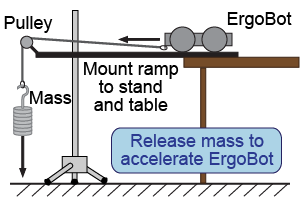| | Essential questions | | How are work, potential energy, force, and distance related graphically? | |
|
To stretch an elastic band, you do work on it to overcome its restoring force. The band gains elastic potential energy in the process. Similarly, work is done against the gravitational force to lift a mass off the floor, and the mass gains gravitational potential energy in the process. How is the work you do related to the potential energy stored and the restoring force? 
|

|
Part 1: Elastic force

- Stretch the elastic band to different distances and measure the force with a spring scale. Record your results.
- Using your computer, click on the graphing tool in the electronic resources to conduct the investigation. Plot a graph of force versus displacement of the band. Use the graph to calculate the elastic potential energy at each displacement.
- For each displacement, release the ErgoBot and capture its motion data on the computer. Record the speed and calculate the kinetic energy.
- How does the work done by the elastic band compare with the kinetic energy Ek of the ErgoBot? Why?
- In step #3 above, what are the independent, dependent, and controlled variables?

|
In this interactive element, you will capture real-time data from the motion of the ErgoBot and display the data as position versus time, velocity versus time, and/or acceleration versus time graphs.
|
|
In Part 1 you are asked to graph force against displacement for the elastic band. Use this data graphing tool (accessed using the button on the left) as a computer investigation aid to enter your data, graph the data, and fit models to the data.
|
Part 2: Gravitational force

- Release the suspended, hooked mass and capture the ErgoBot’s motion data on the computer.
- For at least five points along the motion graph, determine the distance traveled and the acceleration of the ErgoBot.
- Calculate the net force on the ErgoBot at each distance by applying Newton’s second law: Fnet = ma.
- Plot a graph of force versus distance for the ErgoBot.
- Use the motion graphs to determine the maximum velocity of the ErgoBot at the end of its accelerated motion. What was its maximum kinetic energy?
- Calculate the total work done on the ErgoBot from the area under the graph of force versus distance.
- How does the total work done on the ErgoBot compare with its maximum kinetic energy?

| |
| |
|

